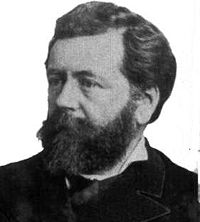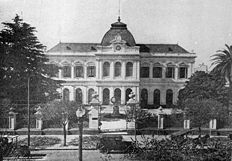
Dardo Rocha
Encyclopedia

La Plata
La Plata is the capital city of the Province of Buenos Aires, Argentina, and of La Plata partido. According to the , the city proper has a population of 574,369 and its metropolitan area has 694,253 inhabitants....
and of the University of La Plata.
Life and times
Juan José Dardo Rocha was born to Colonel Juan José Rocha and Juana Arana in Buenos AiresBuenos Aires
Buenos Aires is the capital and largest city of Argentina, and the second-largest metropolitan area in South America, after São Paulo. It is located on the western shore of the estuary of the Río de la Plata, on the southeastern coast of the South American continent...
in 1838. Enrolling at the University of Buenos Aires
University of Buenos Aires
The University of Buenos Aires is the largest university in Argentina and the largest university by enrollment in Latin America. Founded on August 12, 1821 in the city of Buenos Aires, it consists of 13 faculties, 6 hospitals, 10 museums and is linked to 4 high schools: Colegio Nacional de Buenos...
, Rocha interrupted his studies to enlist as a naval cadet in 1859, placing him in the Battle of Pavón
Battle of Pavón
The Battle of Pavón was a key battle of the Argentine civil wars fought in Pavón, in Santa Fé Province, Argentina, on September 17, 1861, between the Army of Buenos Aires, commanded by Bartolomé Mitre, and the National Army, commanded by Justo José de Urquiza...
, an 1861 encounter resulting in the unification of the Province of Buenos Aires into the Argentine Republic. He graduated with a Law Degree in 1863, but remained in the Argentine Navy
Argentine Navy
The Navy of the Argentine Republic or Armada of the Argentine Republic is the navy of Argentina. It is one of the three branches of the Armed Forces of the Argentine Republic, together with the Army and the Air Force....
during the War of the Triple Alliance
War of the Triple Alliance
The Paraguayan War , also known as War of the Triple Alliance , was a military conflict in South America fought from 1864 to 1870 between Paraguay and the Triple Alliance of Argentina, Brazil, and Uruguay...
and was critically wounded during the 1866 Battle of Curupaity
Battle of Curupaity
The Battle of Curupayty was a key battle in the War of the Triple Alliance.On the morning of September 22, 1866, the joint force of the Imperial , Argentine and Uruguayan armies attacked Paraguayan fortified trenches on Curupaity. The Paraguayans were led by General José E. Díaz...
, causing his return to civilian life as a lawyer, whereupon he married Paula Arana.
Invited to take part in the 1870 Constitutional Reform Convention of the Province of Buenos Aires, he was elected to the Argentine Chamber of Deputies
Argentine Chamber of Deputies
The Chamber of Deputies is the lower house of the Argentine National Congress. This Chamber holds exclusive rights to create taxes, to draft troops, and to accuse the President, the ministers and the members of the Supreme Court before the Senate....
(the Lower House of Congress) in 1873 and to the Argentine Senate
Argentine Senate
The Argentine Senate is the upper house of the Argentine National Congress. It has 72 senators: three for each province and three for the Autonomous City of Buenos Aires...
in 1874, where he became a leading member of Julio Roca's National Autonomist Party
National Autonomist Party
The National Autonomist Party was an Argentine political party during the 1874-1916 period. Created on March 15, 1874 by the union of the Autonomist Party of Adolfo Alsina and the National Party of Nicolás Avellaneda...
, to whose platform the federalization of Buenos Aires was central. Rocha became a prominent proponent of this policy in Congress, where he also earned plaudits for his work to regulate commerce along the contraband-laden Bermejo River
Bermejo River
The Bermejo River is a river in South America that flows from Bolivia to the Paraguay River in Argentina. The river is generally called Bermejo in spite of its different names along its way, but it also has its own Native American names; in Wichí it is called Teuco, and in Guaraní it is called Ypitá...
bordering Paraguay
Paraguay
Paraguay , officially the Republic of Paraguay , is a landlocked country in South America. It is bordered by Argentina to the south and southwest, Brazil to the east and northeast, and Bolivia to the northwest. Paraguay lies on both banks of the Paraguay River, which runs through the center of the...
, for the enactment of the nation's first patent laws and for his support of protectionism
Protectionism
Protectionism is the economic policy of restraining trade between states through methods such as tariffs on imported goods, restrictive quotas, and a variety of other government regulations designed to allow "fair competition" between imports and goods and services produced domestically.This...
for the nation's small, but growing industrial sector.
The prominence he earned in the Senate led to his becoming its Provisional President in 1877, whereby he served as acting President of Argentina
President of Argentina
The President of the Argentine Nation , usually known as the President of Argentina, is the head of state of Argentina. Under the national Constitution, the President is also the chief executive of the federal government and Commander-in-Chief of the armed forces.Through Argentine history, the...
during the ailing Nicolás Avellaneda
Nicolás Avellaneda
Nicolás Remigio Aurelio Avellaneda Silva was an Argentine politician and journalist, and president of Argentina from 1874 to 1880. Avellaneda's main projects while in office were banking and education reform, leading to Argentina's economic growth...
's frequent medical leaves of absence. Newly-elected in 1880, President Julio Roca to support Rocha's candidacy as Governor of Buenos Aires Province, the nation's most important and most politically contentious at the time. Following a failed insurrection against the Roca regime, his message of political integration with the suddenly prosperous Argentina persuaded the province's voters, and he was elected in 1881. Facing ongoing secessionist pressures from his constituency, Governor Rocha proposed the creation of a new provincial capital in replacement of the city of Buenos Aires, which was federalized as the nation's capital in 1880. The proposal, useful to the mollification of the province's Independence-leaning gentry, was quickly approved by Congress. Overseeing a furor of construction, Rocha inaugurated the city of La Plata
La Plata
La Plata is the capital city of the Province of Buenos Aires, Argentina, and of La Plata partido. According to the , the city proper has a population of 574,369 and its metropolitan area has 694,253 inhabitants....
on November 19, 1882, creating the first planned city in South America and its first with electric lighting.
La Plata was planned by architect Pedro Benoit
Pedro Benoit
Pedro Benoit was an Argentine architect, engineer and urbanist best known for designing the layout of the city of La Plata.-Life and times:...
in a regular pattern of diagonals and precisely-placed squares. His success in La Plata led the governor to seek his party's nomination for the Presidency in 1886. Rocha was a well-known, well-connected and persuasive candidate who had secured his place among Argentina's paramount Generation of 1880
Generation of '80
The Generation of '80 was the governing elite in Argentina from 1880 to 1916. Members of the oligarchy of the provinces and the country's capital, they first joined the League of Governors , and then the National Autonomist Party...
, but lost the nomination to Miguel Juárez Celman, the Governor of the Province of Córdoba
Córdoba Province (Argentina)
Córdoba is a province of Argentina, located in the center of the country. Neighboring provinces are : Santiago del Estero, Santa Fe, Buenos Aires, La Pampa, San Luis, La Rioja and Catamarca...
and President Roca's son-in-law.

Revolution of the Park
The Revolution of the Park was an uprising against the national government of Argentina that took place on 26 July 1890 and started with the takeover of the Buenos Aires Artillery Park. It was led by members of the Civic Union against the presidency of Miguel Juárez Celman...
, Rocha devoted his time to the growing city he had founded, for which he established the University of La Plata in 1897, staying on as its President until the school's nationalization in 1905. His additional responsibilities as Director of the Constitutional Law syllabus at the school did not precluse Rocha from accepting a commission as Argentine observer to the 1904 Bolivia-Chile Border Demarcation Treaty.
Dardo Rocha died in Buenos Aires in 1921 at age 83. His unassuming La Plata home is today maintained as the Dardo Rocha Museum & Archives.

